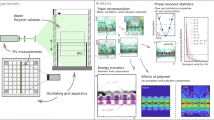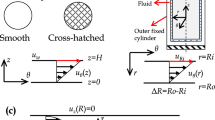Abstract
A Laser-Doppler anemometer and a pressure transducer were used to carry out detailed measurements of the mean and root mean square of the velocity and wall-pressure in an axisymmetric sudden expansion flow, with 0.4 and 0.5% by weight shear-thinning aqueous solutions of a low molecular weight polymer (6,000), after appropriate rheological characterisation. In spite of their very low molecular weight, these solutions still exhibited elongational elastic effects through drag reduction of up to 35% relative to Newtonian turbulent pipe flow, as shown by Pereira and Pinho (1994).
The results showed small variations of the recirculation bubble length with polymer concentration and Reynolds number and reductions of the normal Reynolds stresses of up to 30%, especially in the tangential and radial directions. The reduction in normal Reynolds stresses within the shear layer is an elongational elastic effect, but this elasticity needs to be considerably more intense, such as with high molecular weight polymers, in order to strongly affect the mean flow characteristics. The observed mean flow patterns with these low molecular weight polymer solutions were indeed similar to those exhibited by Newtonian and inelastic fluids.
Similar content being viewed by others
Abbreviations
- D :
-
diameter of pipe downstream of sudden expansion
- d :
-
diameter of pipe upstream of sudden expansion
- ER :
-
expansion ratio
- h :
-
step height
- K :
-
consistency index in power law model
- k :
-
turbulent kinetic energy
- L :
-
recirculation bubble length
- n :
-
power law index in power law and Carreau viscosity models
- R :
-
radius of pipe downstream of sudden expansion
- Re :
-
Reynolds number
- Re a :
-
Reynolds number based on wall viscosity in the upstream pipe
- Re gen :
-
generalised Reynolds number (Eq. 4)
- r :
-
local radius
- U :
-
axial bulk velocity
- U in :
-
axial bulk velocity at inlet
- u :
-
local axial mean velocity
- u 0 :
-
axial centreline velocity
- u′ :
-
local root mean square of axial velocity
- v′ :
-
local root mean square of radial velocity
- w′ :
-
local root mean square of tangential velocity
- \(\dot \varepsilon\) :
-
dissipation rate of turbulence
- \(\dot \gamma\) :
-
shear rate
- λ :
-
time constant of Carreau viscosity model
- ϱ :
-
fluid density
- μ :
-
fluid viscosity
- μ a :
-
viscosity at the wall in the upstream pipe
- μ 0 :
-
zero shear-rate viscosity
- ch :
-
refers to a characteristic value
- in :
-
refers to characteristic values at the inlet pipe
- max:
-
refers to maximum values
References
Abbott DC; Kline; SJ (1962) Experimental investigation of subsonic turbulent flow over single and double backward facing steps. ASME J Basic Eng 84: 317–325
Back LH; Roschke EJ (1972) Shear-layer flow regimes and wave instabilities and reattachment lengths downstream of an abrupt circular channel expansion. ASME J Appl Mech Sept. 677–681
Berman NS; Tan H (1985) Two-component laser-doppler velocimeter studies of submerged jets of dilute polymer solutions. AICHE J 2: 208–215
Boger DV; Walters K (1994) Private communication on “The influence of asymmetric inlet conditions on viscoelastic flow through contractions”. 1994 Lecture Series Programme of the von Karman Institute for Fluid Dynamics on “Non-Newtonian Fluid Mechnanics”
Castro OS (1994) Non-Newtonian turbulent flow in a sudden expansion. MSc. Thesis (in Portuguese). University of Porto, Portugal
Cherdron W; Durst F; Whitelaw JH (1978) Asymmetric flows and instabilities in symmetric ducts with sudden expansions. J Fluid Mech 84: 13–31
Cherry NJ; Hillier R; Latour MEMP (1984) Unsteady measurements in a separated and reattaching flow. J Fluid Mech 144: 13–46
Dimaczek G; Tropea C; Wang AB (1989) Turbulent flow over two-dimensional surface-mounted obstacles: plane and axisymmetric geometries. In: Advances in Turbulence 2, Springer Verlag, Heidelberg.
Durrett RP; Stevenson WH; Thompson HD (1988) Radial and axial turbulent flow measurements with an LDV in an axisymmetric sudden expansion air flow. ASME J Fluids Eng 110: 367–372
Durst F; Melling A; Whitelaw JH (1981) Principles and Practice of Laser-Dopper Anemometer, 2nd edition, Academic Press, London
Freeman AR (1975) Laser anemometer measurements in a recirculating region downstream of a sudden pipe expansion. Proceedings of the LDA Symposium, Copenhagen, pp 704–709
Halmos AL; Boger DV (1975) The behaviour of a power law fluid flowing through a sudden expansion. Part II. Experimental verification. AICHE J 21: 550–553
Halmos AL; Boger DV; Cabelli A (1975) The behaviour of a power law fluid flowing through a sudden expansion. Part I. Numerical solution. AICHE 21: 540–549
Hinch EJ (1977) Mechanical models of dilute polymer solutions in strong flows. Phys Fluids 20: S22-S30
Hoyt JW (1972) The effect of additives on fluid friction. ASME J Basic Eng 94: 258–285
Iribarne A; Frantisak F; Hummel RL; Smith JW (1972) An experimental study of instabilities and other flow properties of a laminar pipe jet. AICHE J 18: 689–698
Kalinske AA (1946) Conversion of kinetic to potential energy in flow expansions. Trans ASCE 355–359
Khezzar L; Whitelaw JH; Yianneskis M (1985) An experimental study of round sudden expansion flows. Proc. 5th Symp. on Turb. Shear Flows. Cornell University: 5–25
Kostic M (1994a) On turbulent drag and heat transfer reduction phenomena and laminar heat transfer enhancement in non-circular duct flow of certain non-Newtonian fluids. Int J Heat Mass Transfer 37: 133–147
Kostic M (1994b). Different non-Newtonian Reynolds and Prandtl numbers: their usage and relationships. ASME Symposium on “Developments in Non-Newtonian Flows II”, FED Vol. 206 & AMD Vol. 191: 163–169
Kozicki W; Chou CH; Tiu C (1966) Non-Newtonian flow in ducts of arbitrary cross sectional shape. Chem Eng Sci 21: 665–679
Koziol K; Glowacki P (1989) Turbulent jets of dilute polymer solutions. J Non-New Fluid Mech 32: 311–328
Luchik TS; Tiederman WG (1988) Turbulent structure in low concentration drag-reducing channel flows. J Fluid Mech 190: 241–263
Mecagno EO; Hung TK (1966) Computation and experimental study of a captive annular eddy. J Fluid Mech 28: 43–64
Moon LF; Rudinger G (1977) Velocity distribution in an abruptly expanding circular duct. ASME J Fluids Eng 99: 226–230
Pak B; Cho YI; Choi SU (1990) Separation and reattachment of non-Newtonian fluid flows in a sudden expansion pipe. J Non-Newt Fluid Mech 37: 175–179
Pak B; Cho YI; Choi SU (1991) Turbulent hydrodynamic behavior of a drag-reducing viscoelastic fluid in a sudden expansion pipe. J Non-Newt Fluid Mech 39: 353–373
Pereira AS; Pinho FT (1994) Turbulent pipe flow characteristics of low molecular weight polymer solutions. J Non-Newt Fluid Mech 55:321
Perera MGN; Walters K (1977) Long range memory effects in flows involving abrupt changes in geometry. Part 2: The expansion/ contraction/expansion Problem. J Non-Newt Fluid Mech 2: 191–204
Pinho FT; Whitelaw JH (1991) Flow on non-Newtonian fluids over a confined baffle. J. Fluid Mech 226: 475–496
Politis S (1989) Turbulence Modelling of Inelastic Power-Law Fluids. Brite report RIIB.0085. UK(H)-Technical report 52 Imperial College, London
Restivo AO; Whitelaw JH (1978) Turbulence Characteristics of the Flow Donstream of a Symmetric, Plane, Sudden Expansion. ASME J Fluids Eng 100: 308–310
Stieglmeier M; Tropea C (1992) A miniaturized, mobile laser-doppler anemometer. Appl Optics 111: 4096–4099
Stieglmeier M; Tropea C; Weiser N; Nitsche W (1989) Experimental investigation of the flow through axisymmetric expansions. ASME J Fluids Eng 111: 464–471
Townsend P; Walters K (1994) Expansion flows of non-Newtonian liquids. Chem Eng Sci 49: 749–763
Virk PS (1975) Drag reduction fundamentals. AICHE J 21: 625–656
Walters K; Webster MF(1982) On dominating elastico-viscous response in some complex flows. Phil Trans Roy Soc London A 308: 199–218
Author information
Authors and Affiliations
Additional information
This paper is dedicated to the memory of late Professor A.O. Restivo
The authors acknowledge the support of the ex-Instituto Nacional de Investigação Científica — INIC, Instituto de Engenharia Mecânica e Gestão Industrial — INEGI and Laboratório de Hidráulica da Faculdade de Engenharia in helping to finance the rig, lending some equipment and for providing building space for the installation, respectively. We also would like to thank M. Paulo Coelho and Ms. Doris Dobbelman for their contribution to the measurements and Hoechst, Portugal for providing us with some of the polymer additives.
Rights and permissions
About this article
Cite this article
Castro, O.S., Pinho, F.T. Turbulent expansion flow of low molecular weight shear-thinning solutions. Experiments in Fluids 20, 42–55 (1995). https://doi.org/10.1007/BF00190597
Received:
Accepted:
Issue Date:
DOI: https://doi.org/10.1007/BF00190597




